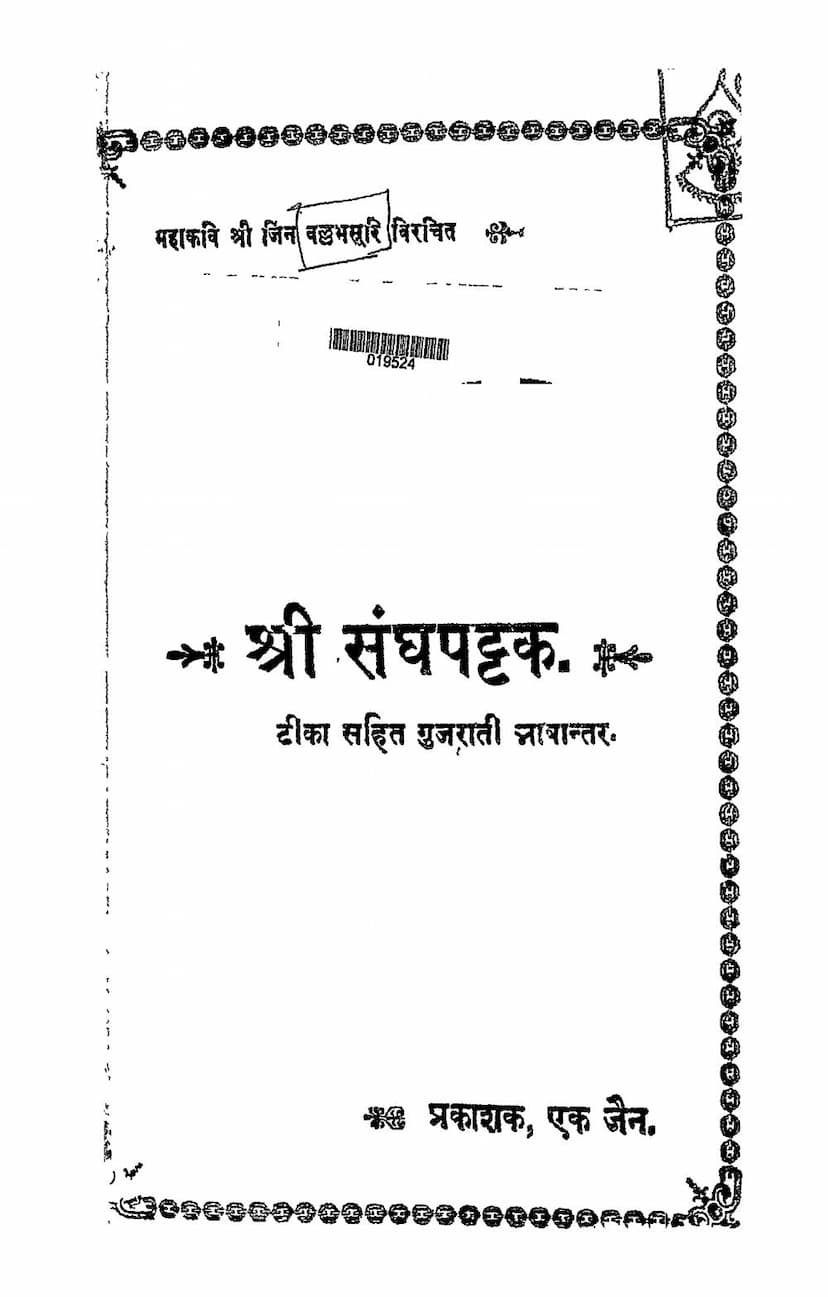Sanghpattak
Added to library: September 2, 2025

Summary
Here's a comprehensive summary of the Jain text "Sanghpattak" by Jinavallabhsuri, based on the provided text:
Overall Purpose and Context:
The "Sanghpattak" is a significant Jain text composed by Mahakavi Jinavallabhsuri. The text, presented here with a Gujarati translation, aims to critique and refute the "Chaityavasi" (monks who resided in temples) practices, which had emerged as a deviation from the original "Nirgranth" (ascetic) path established by Lord Mahavir. The work emphasizes the importance of adherence to the prescribed scriptural path ("Vidhi Marg") and highlights the decline in spiritual conduct and adherence to true Jain principles during the period of Chaityavadi influence.
Author and Commentary:
- Author: Mahakavi Jinavallabhsuri, a disciple of Navangi Vruttikkar Shri Abhaydevsurishri.
- Commentary: The text is accompanied by a commentary of 3,000 verses by Mahanayik Shri Jinpatisuri, who was the guru of Nemichandagarik, the author of the "Shashisatak Granth." This commentary provides detailed explanations and arguments to support the author's points.
Historical Background and Critique of Chaityavadi Practices:
The text delves into a historical account of the Jain tradition, tracing its lineage from Lord Mahavir.
-
Original Path (Nirgranth Tradition):
- Monks were called "Nirgranth," meaning those who are devoid of wealth and possessions.
- They resided in forests or outskirts of villages, or in rented houses within villages.
- They did not hoard possessions, used simple bedding, avoided conflicts, and remained engrossed in meditation.
- They lived detached from worldly entanglements and guided people to the true path.
- This practice continued for about a thousand years after Lord Mahavir, guided by their virtuous gurus.
-
Emergence of Chaityavadi Practices:
- Around 50 years after Lord Mahavir's nirvana, some monks began to reside in temples ("Chaityavas"), deviating from the traditional path.
- Devardhigani Kshamashramanan, around 1000 years after Lord Mahavir, compiled Jain scriptures into written form.
- After Devardhigani's passing, Chaityavasis gained more influence, leading to a decline in strict adherence to the scriptures.
- To justify their practices, scriptures were secretly created, disguised as commentaries on the 12th Anga (Drishtivada). These scriptures promoted temple living, acceptance of money for necessary tasks, and possession of books.
- This led to a decline in the prestige of traditional monks and an increase in laxity and corrupt practices, including engaging in trade and accumulating wealth.
- The concept of "Gachh" (sect or lineage) became associated with pride and rivalry, leading to internal conflict and the fragmentation of the tradition.
- This period is described as the fifth Arā (era) of the Avsarpini (descending cycle of time), characterized by an increase in these negative influences.
- The text criticizes the abandonment of true monastic principles, the adoption of practices like accepting money, and the misinterpretation of scriptures to justify these deviations.
Jinavallabhsuri's Contribution and the Sanghpattak:
- Refutation of Chaityavadi Practices: Jinavallabhsuri, inspired by the correct path and his preceptors, actively challenged the Chaityavadi practices. He composed the "Sanghpattak," a work of 40 verses, using his poetic and argumentative prowess to refute their doctrines.
- Purpose of Sanghpattak: The text aimed to expose the deviations of the Chaityavasis, highlight their deviation from scriptural injunctions, and stir the followers of the "Vidhi Marg" (path of righteousness).
- Legacy and Impact:
- The "Sanghpattak" was inscribed on stone pillars at the Vira Prabhu temple in Chitor, a testament to its significance and the conviction behind its message.
- The text recounts the efforts of subsequent Acharyas like Jinadattasuri and Jinapatisuri, who continued the struggle against the Chaityavasi influence, with Jinpatisuri's extensive commentary on "Sanghpattak" being particularly noteworthy.
- The text traces the victory of the "Vastivasi" (monks who followed the traditional path) over the "Chaityavasi" in various regions, leading to the decline of Chaityavasi influence.
- The narrative highlights the eventual resurgence of the pure Jain path after approximately a thousand years of Chaityavadi dominance, with the suppression of their supporting scriptures and the re-emergication of the "Nirgranth Pravachan."
Key Themes and Criticisms:
- Idolatry of Ritual over Substance: The text criticizes the focus on external rituals and temple adornment by the Chaityavasi, neglecting the core principles of detachment, austerity, and spiritual practice.
- Misuse of Temple Funds and Wealth Accumulation: The text condemns the acceptance of money and the accumulation of wealth by monks, which was contrary to the ascetic ideals.
- Deviation from Scriptural Teachings: A central theme is the critique of the Chaityavasi for deviating from the original Jain scriptures and creating new interpretations to justify their actions.
- Importance of True Renunciation: The text emphasizes the value of genuine renunciation, detachment, and adherence to the core tenets of Jainism as embodied by the Nirgranth tradition.
- Critique of Hypocrisy: The text exposes the hypocrisy of monks who outwardly appeared religious but inwardly were driven by worldly desires and pride.
- The Role of the Guru: The importance of following a true and virtuous guru who adheres to the scriptures is implicitly highlighted through the positive portrayal of Jinavallabhsuri and his lineage.
The "Sanghpattak" as a Call to Action:
The text is not just a historical critique but also a call to the Jain community to understand the true path, uphold scriptural values, and remain vigilant against deviations from the pure teachings of Jainism. The publishers express the hope that the translation will awaken the people to these truths.
In essence, the "Sanghpattak" is a powerful defense of the traditional Jain ascetic path against the corrupting influences of temple-dwelling monks, advocating for a return to the core principles of renunciation, scriptural adherence, and genuine spiritual discipline.